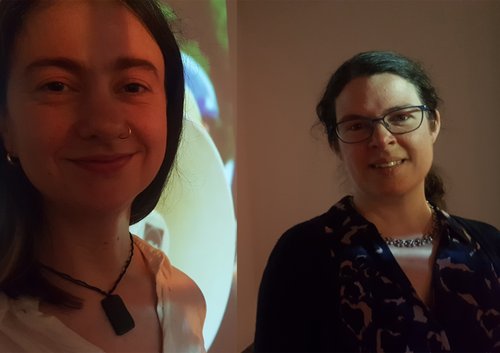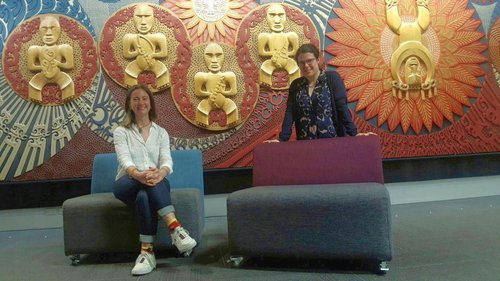
What are the inner workings of an audiovisual archive? Who are the people that do the actual archiving?
In part one, we check in with the Documentation team to learn more about them and the great job they do.
The Documentation team have a lot on their hands: boxes and boxes of scripts, photographs, production records, costumes, props, animation cels, scrapbooks and much more. The documentation and artefacts generated during the development of film, television and sound productions reflect changes across the wider media landscape in Aotearoa.
Working through and caring for all this material is the small but mighty duo of Tracy White and Charlotte Thompson Darling. Both have plenty of experience working with paper-based collections. White spent several years working with the special collections in the JC Beaglehole Room at Victoria University of Wellington before taking up her current position at Ngā Taonga, where she has worked for nearly six years.
Thompson Darling has previously worked at the Alexander Turnbull Library and Wai-te-ata Press.
Hero image: Charlotte Thompson Darling & Tracy White at the Rust + Restoration exhibition. Photo by Mishelle Muagututi’a.

Documentation archivists Charlotte Thompson & Tracy White. Photo by Mishelle Muagututi’a.
Can you describe your job in a few words?
Charlotte – eclectic, detailed, dusty.
Tracy – variety, challenge, meticulous, contribute, share. Our work has huge variety and is both inward and outward facing.
Do you have any favourite items from the collection?
Charlotte
- Len Lye’s Peanut Vendor puppet – I think it’s terrifying but also fascinating.
- Temuera Morrison’s boots from Once Were Warriors – when I started here, I wasn’t expecting costumes to be part of the job. It made me happy to learn that they were.
- The TVNZ stock photo collection – these aren’t from productions but were used in productions. They’d be things like a photo on a wall in a TV show. There’s lots of photos of supermarkets; a closeup of a guy brushing his teeth. There’s a surprisingly large section on goats.
- A scrapbook that belonged to my grandfather – he was the manager of a cinema and kept track of movie listings.
- The Keri de Carlo collection of glamour shots – it tells us how we watch movies, not just who made them and how, but also about the people who watch at home.
Tracy
- A scrapbook by Luke Wilson, a cinema manager in Stratford. It was compiled during the 1920s and early 30s. He managed the King’s Theatre, Stratford and the Kosy Theatre in Palmerston North. It’s small but packed full or black and white photos, newspaper clippings referring to his successes in theatre publicity, correspondence commending his achievements and some examples of promotional ephemera. Some photographs provide evidence of ‘stunts’ he organised to promote movies – kids dressed up in costume and carrying signs encouraging punters ‘come see this or that movie’. And competition entries like writing the name of a film as many times as you could in a very small space.
- The ‘hole in a wall’ from the Pacific Films collection – it’s from their office. We think someone may have kicked the wall in a temper and then signed it. This is possibly one of the more unusual of our collection items!
- The Peanut Vendor puppet – it was beautifully constructed by Len Lye himself and is now around 85 years old. It often engenders opposite reactions, like ‘wow, he’s lovely!’ or ‘uggh!’ Seeing the puppet dancing in the film context makes it potentially less scary than when it’s lying in its coffin-like box with its eyes stored separately.
- The Sir Robert J. Kerridge theatre album – a gorgeous album compiled c. 1945 to record the cinemas in the Kerridge chain. It’s professionally made with hand drawn maps of the country including searchlights that show where cinemas are located and a hand lettered index and captions. It’s really beautiful in chalk pastels on black paper, with black and white photos of the facades, foyers and auditorium of each cinema.

Tracy White & Charlotte Thompson Darling in the 'Rust + Restoration' exhibition. The archivists helped select some of the objects on display. Photo by Mishelle Muagututi’a.
Have you had any really memorable events during your work here?
Charlotte – I’m pretty new here so it would probably be the move! It was a nice chance to get to know the collection, just dive in and have a nosy. I also enjoyed working on the Rust + Restoration exhibition: choosing objects and setting them up. It was exciting to help do the research for the text labels.
Tracy – There’s been so many great events over the last few years. Processing the Pacific Films collection – over 200 boxes – was a huge, satisfying task. It was also great to work with John Reid and see his book 'Whatever it Takes: Pacific Film and John O'Shea 1948 - 2000' come to fruition. I have loved having the opportunity to be involved with the Siapo Cinema film festival, thanks to my colleague and lead curator Mishelle Muagututi’a – there have been some amazing events, films and kōrero organised. The Documentation team has provided photographs and documents and assisted with research towards many other interesting projects, too.